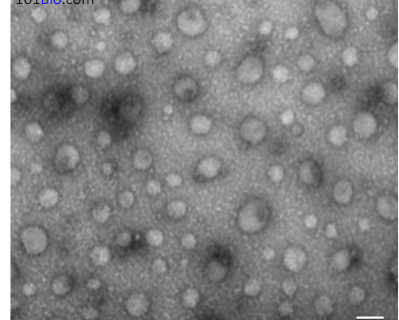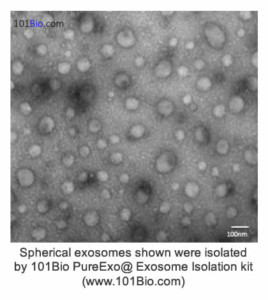
Exosomes: A Major Phenomenon Flying Under the Radar
A guest blog by William G. Whitford, Strategic Solutions Leader, BioProcess, GE Healthcare Life Sciences
Exosomes in Nature
It was discovered some time ago that eukaryotic cells regularly secrete such structures as microvesicles, macromolecular complexes, and small molecules into their ambient environment. Exosomes are one of the types of natural nanoparticles (or nanovesicles) that have shown promise in many areas of research, diagnostics and therapy. They are small lipid membrane vesicles (30-120 nm) generated by fusion of cytoplasmic endosomal multivesicular bodies within the cell surface. Exosomes are found throughout the body in such fluids as blood, saliva, urine, and breast milk. Furthermore, all types of cells secrete them in in vitro culture. It is believed that they have many natural functions, including acting as transporters of nucleic acids (mostly RNA), cytosolic proteins and metabolites to many cells, tissues or organs throughout the body. Much remains to be understood regarding how they are formed, as well as of their targeting and ultimate physiological activity. But many don’t realize that some activities have been rather thoroughly demonstrated─ such as their function in some sort of either local or more systemic intercellular communication.
Exosomes as Tools
General interest in exosomes is now growing for many reasons. One is because of the observation of their natural activity with antigen-presenting cells and in immune responses in the body. Their potential as very powerful biomedical tools of both diagnostic and therapeutic value is now being more widely reported. Applications described include using them as immunotherapeutic reagents, vectors of engineered genetic constructs, and vaccine particles. They’ve also been described as tools in the diagnosis or prognosis of a wide variety of disorders, such as cancer and neurodegenerative diseases. Also, their potential in tissue-level microcommunication is driving interest in such therapeutic activities as cardiac repair following heart attacks. Their potential as biomarkers is being explored because their content has been described as a “fingerprint” of differentiation or signaling or regulation status of the cell generating them. For example, by monitoring the exosomes secreted by transplanted cells, one may be able to predict the status or potentially even the outcome of Cell Therapy procedures. Clinical trials are in progress for exosomes in many therapeutic functions, for many indications. One example is using dendritic cell-derived exosomes to initiate immune response to cancers.
Exosome Manufacturing
Exosome product manufacturing involves many distinct areas of study. First of all, we are interested in their efficient and robust generation at a sufficient scale. Also, because they are found in such raw materials as animal serum, avoiding process-related contaminants is a concern. Finally, a variety of means of separating them from other types of extracellular vesicles and cell debris is under study. As exosomes are being examined in so many applications, their production involves many distinct platforms and concerns. First of all, an appropriate and effective culture mode is required for any cell line that is specifically required by the application. Also, one must consider the quality systems and regulatory status of the materials and manufacturing environment for the particular product addressed. Finally, a robust process must be described for the scale and duration of production demanded. As things exist now, their production can be described as 1) the at-scale expansion and culture of the parent cell-line, 2) the collection or harvest of the culture media containing the secreted exosomes, and 3) the isolation or purification of the desired exosomes from not only other macrovesicles, macromolecular complexes, and small molecules, but from such other process contaminants as cellular debris and culture media components.
Scalable Exosome Production
At the laboratory-scale any number of culture, harvest and purification approaches have been reported. But, regulated biomanufacturing-scale production in classified environments imposes some serious constraints upon the production methods that can be considered. All types of cells are currently being considered in large-scale exosome production─ from transformed cell lines to mesenchymal stem cells to ex vivo primary human cells. Production platforms now being regularly employed include scaling-out (replicating individual culture vessels) using a large number of T-225 flasks. Also, there are many using stacked array multiplate flasks and any number of packed-bed bioreactors. Exosomes are secreted at a rather low cell-specific productivity and a standard preparation in a batch-mode process can entail a final stage of hundreds of T225 flasks or the use of rather expensive and technically challenging multiplate flask systems or bioreactors. In many of these approaches several rounds of splitting and culture expansion are required to attain the necessary cell-mass. They can also present such technical challenges as their constituent cells undergoing apoptosis just prior to harvest, contaminating it with membrane fragments.
 Culture medium for large –scale production must not only support the robust expansion of the platform’s cell-line, but should also reduce process-related contaminants and support efficient purification of the exosome product. An important issue here is that all natural fetal bovine serum (FBS) contains endogenous exosomes that can significantly contaminate the secreted exosome product. In classical media-based production (such as in RPMI1640/10% FBS) this results in the need to either eliminate serum from the medium immediately following cell-mass expansion, or to employ one of the many exosome-depleted animal sera now available on the market. Culture of the production cells in serum-free medium (SFM) can be considered, there are not always formulations demonstrated to expand the platform cell-line robustly, at-scale, in the production mode of choice. Also, an identified SFM must be specifically validated to support the quality and quantity of exosomes desired.
Culture medium for large –scale production must not only support the robust expansion of the platform’s cell-line, but should also reduce process-related contaminants and support efficient purification of the exosome product. An important issue here is that all natural fetal bovine serum (FBS) contains endogenous exosomes that can significantly contaminate the secreted exosome product. In classical media-based production (such as in RPMI1640/10% FBS) this results in the need to either eliminate serum from the medium immediately following cell-mass expansion, or to employ one of the many exosome-depleted animal sera now available on the market. Culture of the production cells in serum-free medium (SFM) can be considered, there are not always formulations demonstrated to expand the platform cell-line robustly, at-scale, in the production mode of choice. Also, an identified SFM must be specifically validated to support the quality and quantity of exosomes desired.
Packed-bed reactors and hollow-fiber bioreactors (HFBR) have been employed in biotechnology for years, and their utility in the efficient and scalable production of exosomes has recently been reported (1). They provide an extensive growth surface area supporting a large numbers of cells at high densities. The immobilization of cells on a matrix or isolation through the molecular weight cut-off of the hollow-fiber, allows waste products to pass through or away and fresh metabolites to appear. Packed bed reactors allow the secreted exosomes to be collected from the reactor perfusate, but others retain such larger secreted product as proteins, antibodies, viruses and exosomes so they accumulate and concentrate. Here the cultured cells are bound to a porous support so that splitting is not required, and many cell-lines grow post-confluence without significant apoptosis (2). In some applications collection of secreted products can be maintained over several months of continuous production. Importantly, in the HFBR exosomes cannot cross the fiber in either direction so standard serum (E.g., HyCloneTM Characterized FBS #SH30071, GE Healthcare, MA USA) can be used in the circulating medium without contaminating the secreted exosomes within the extracapillary space of the cartridge. Commercially available systems of either approach provide single-use and closed production.
Exosome Fractionation or Purification
Following their harvest or collection, purification (or fractionation of the harvest) of these 30-120 nm lipid microvessicles at the laboratory-scale can be addressed by a variety of means. The methods described employ one or more distinct properties or characteristics of exosomes, including their size, density, morphology, composition, zeta potential, biochemical or immunological features. Methods successfully employed include velocity and density gradients, agglomeration or precipitation via volume-excluding polymers, such as PEG or identified peptides, and a number of commercially available kits employing such proprietary means as active-ligand coated beads for adsorption chromatography (3). Each method described has been designed to exploit specific physical or chemical properties of the exosomes, or their impurities, to separate them from heterogeneous biological harvest. Each yields exosomes at a different efficiency, with different types and amounts of contaminants. But, the economic and large-scale purification of exosomes in a regulated environment significantly limits the technologies that may be considered. Currently popular methods include multiple preliminary rounds of centrifugation or microfiltration, followed by ultracentrifugation or nanofiltration.
Conclusion
Exosomes have many and significant functions with the body. Many applications for them are being discovered in the areas of research, diagnostics and medical therapy. Work is progressing on their production, at scale, in an appropriate quality and regulatory environment.
References
- John W. Ludlow, Benjamin Buehrer, and John J. S. Cadwell, Scalable production of exosomes and their potential use as a therapeutic for tendinopathy,Poster presentation, International Society for Extracellular Vesicles Annual Meeting, April 23-26, 2015
- Advances in Biochemical Engineering/Biotechnology. Series Editors: Scheper, Th., Belkin, S., Doran, P.M., Gu, M.B., Hu, W.-S., Mattiasson, B., Nielsen, J., Seitz, H., Stephanopoulos, G.N., Ulber, R., Zeng, A.-P., Zhong, J.-J., Zhou, W. Disposable Bioreactors II Editors: Eibl, Dieter, Eibl, Regine (Eds.) 2014
- Rebecca E. Lane, Darren Korbie, Will Anderson, Ramanathan Vaidyanathan & Matt Trau, Analysis of exosome purification methods using a model liposome system and tunable-resistive pulse sensing, Scientific Reports, Article number: 7639, 06 January 2015 http://www.nature.com/srep/2015/150105/srep07639/full/srep07639.html
Author Information

William G. Whitford
Strategic Solutions Leader, BioProcess
GE Healthcare Life Sciences
925 West 1800 South Logan, Utah 84321